 Calabrese
Calabrese
 The origin of the Black Pig from Calabria remains shrouded in mystery, with two prevailing hypotheses circulating today. One theory suggests its roots trace back to Iberian stock, while an alternative narrative posits its descent from Roman lineage. Historically, these pigs roamed vast expanses of Calabria, where they diversified into several distinct local varieties, including Reggitana, Cosentino, Orielese, Lagonegrese, Catanzarese, Casalinga, and others.
The origin of the Black Pig from Calabria remains shrouded in mystery, with two prevailing hypotheses circulating today. One theory suggests its roots trace back to Iberian stock, while an alternative narrative posits its descent from Roman lineage. Historically, these pigs roamed vast expanses of Calabria, where they diversified into several distinct local varieties, including Reggitana, Cosentino, Orielese, Lagonegrese, Catanzarese, Casalinga, and others.
Across these regional variations, a common thread emerged—their prized attribute of yielding lean, unfatty meat, making them ideal for sausage production, a hallmark of the area''s culinary tradition.
Today, however, the breed''s population is severely diminished, w ...

 Cantonese
Cantonese
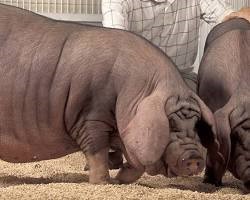 Cantonese pigs, also known by various names including Dahuabai, Ta-hua-pai, Kanton, Chinese, Gongdong Big Spotted, Guangdong Large White Spot, Large Black White, Macao, or Pearl River Delta pigs, are a distinguished breed originating from the fertile Zhujiang delta in Guangdong, China. Revered for their dual-purpose utility in lard and meat production, these pigs exhibit a striking black and white coloration, adding to their visual allure.
Cantonese pigs, also known by various names including Dahuabai, Ta-hua-pai, Kanton, Chinese, Gongdong Big Spotted, Guangdong Large White Spot, Large Black White, Macao, or Pearl River Delta pigs, are a distinguished breed originating from the fertile Zhujiang delta in Guangdong, China. Revered for their dual-purpose utility in lard and meat production, these pigs exhibit a striking black and white coloration, adding to their visual allure.
Resilient and versatile, Cantonese pigs have earned a reputation for their adaptability to the diverse agricultural landscape of the region. Renowned for their robustness, they thrive in the humid subtropical climate of the Zhujiang delta, where they are raised for their high-quality lard and s ...

 Casertana
Casertana
 The Casertana
breed has very ancient origins (Teano or Pelatella): in fact it is
frequently represented in frescoes and sculptures of Roman times. It is
certainly the most precocious among Italian breeds, being able to give large
amounts of fat. At the age of one year these pigs may weigh over 150 kg. The
present situation about this breed is crucial, as only few examples still live,
and not all of them are full-blooded. Rustic, excellent at grazing, frugal and
precocious, they have all the right features to be raised in the open. Their
fertility is limited to an average of 4-6 piglets each delivery up to a maximum
of 10.
The Casertana
breed has very ancient origins (Teano or Pelatella): in fact it is
frequently represented in frescoes and sculptures of Roman times. It is
certainly the most precocious among Italian breeds, being able to give large
amounts of fat. At the age of one year these pigs may weigh over 150 kg. The
present situation about this breed is crucial, as only few examples still live,
and not all of them are full-blooded. Rustic, excellent at grazing, frugal and
precocious, they have all the right features to be raised in the open. Their
fertility is limited to an average of 4-6 piglets each delivery up to a maximum
of 10.Bristles are absent or present in reduced number, that is why the nickname of Pelatella. Another ...

 Celtic
Celtic
 The Celtic pig (Galician: Porco celta) is a distinguished breed native to the autonomous community of Galicia in north-western Spain. While once abundant until the early 20th century, Celtic pigs faced a significant decline, nearly vanishing altogether. However, concerted efforts have led to their gradual recovery, with the population now boasting over 2,500 purebred sows.
The Celtic pig (Galician: Porco celta) is a distinguished breed native to the autonomous community of Galicia in north-western Spain. While once abundant until the early 20th century, Celtic pigs faced a significant decline, nearly vanishing altogether. However, concerted efforts have led to their gradual recovery, with the population now boasting over 2,500 purebred sows.

 Chato Murciano
Chato Murciano
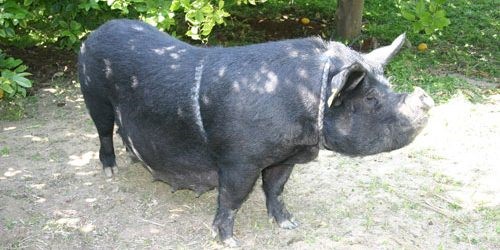 Chato Murciano
pigs are domestic pigs from Murcia, Spain. The Spanish word chato means short-nosed which is how these short-nosed pigs from Murcia got their name.
They are the only surviving breed of pig locally and historically produced in
Murcia and they are at the risk of extinction.
Chato Murciano
pigs are domestic pigs from Murcia, Spain. The Spanish word chato means short-nosed which is how these short-nosed pigs from Murcia got their name.
They are the only surviving breed of pig locally and historically produced in
Murcia and they are at the risk of extinction. Chato Murciano pigs are generally bred for bacon and lean pork and they are well adapted to southern Spains dry and warm climate.
Along with its short nose, the Chato Murciano pigs are generally black or white color and have small heads. Some tend to have white patches on parts of their body such as the tail and legs.
In Murcia, the Spanish were in need of an improved breed of pig as the current Murcian type was ...

 Chester White
Chester White
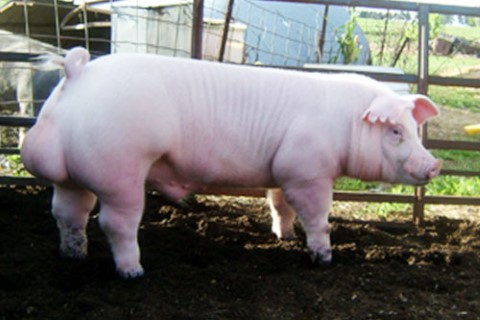 Chester White
pigs originated in Chester County, Pennsylvania. The Chester White was first
developed around 1816, using strains of large white pigs common to the
Northeast U.S. and a white boar imported from Bedfordshire. Some believe
that Chinese pigs might have been added as well.
Chester White
pigs originated in Chester County, Pennsylvania. The Chester White was first
developed around 1816, using strains of large white pigs common to the
Northeast U.S. and a white boar imported from Bedfordshire. Some believe
that Chinese pigs might have been added as well. By 1884 a breed association was officially formed, but competing organizations, sometimes for individual strains, continued to appear into the early 20th century. Finally in 1930 all breed organizations were consolidated under the Chester White Swine Record Association.
Today the Chester White is a versatile breed suited to both intensive and extensive husbandry. Though not as popular as the Duroc, Yorkshire, or Hampshire, the C ...

 Choctaw Hog
Choctaw Hog
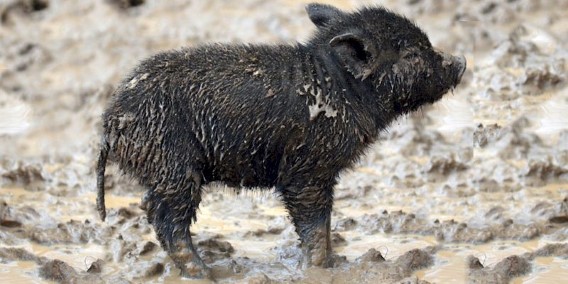 Choctaw Hog are
domestic pig raised by Native Americans for meat. Unfortunately there are only
a few hundred left and are considered critically rare.
Choctaw Hog are
domestic pig raised by Native Americans for meat. Unfortunately there are only
a few hundred left and are considered critically rare. Choctaw hogs are black, sometimes with white markings, and grow to about 120 pounds. Choctaw hogs have two distinctive characteristics: their toes are typically fused forming a single hoof like that of a mule, and many have fleshy wattles on each side of their necks.
Choctaw Hog descend from livestock brought to the Americas by Spaniards in the 16th. The Choctaw Hog was used not only by Native Americans but also by European settlers.
The Choctaw people and their livestock migrated from the Deep South to Oklahoma Territory in the early 19th century. ...

 Cinta Senese
Cinta Senese
 The Cinta Senese is a venerable breed with a rich history originating in the Siena area, specifically around Monteriggioni, Sovicille, and Poggibonsi. Its legacy traces back to the 14th century, as depicted in frescoes portraying pigs adorned with the distinctive white belt reminiscent of present-day Cinta pigs. At its peak, approximately 20,000 Cinta Senese pigs roamed the region, with an equal number thriving in neighboring provinces.
The Cinta Senese is a venerable breed with a rich history originating in the Siena area, specifically around Monteriggioni, Sovicille, and Poggibonsi. Its legacy traces back to the 14th century, as depicted in frescoes portraying pigs adorned with the distinctive white belt reminiscent of present-day Cinta pigs. At its peak, approximately 20,000 Cinta Senese pigs roamed the region, with an equal number thriving in neighboring provinces.
Rustic and resilient, these pigs excel in grazing and exhibit exceptional maternal instincts. Male Cinta Senese pigs can exceed 150 kilograms by their first year, while females typically reach around 140 kilograms. Noteworthy for their robust fat deposits, particularly along the back, this breed ...

 Creole
Creole
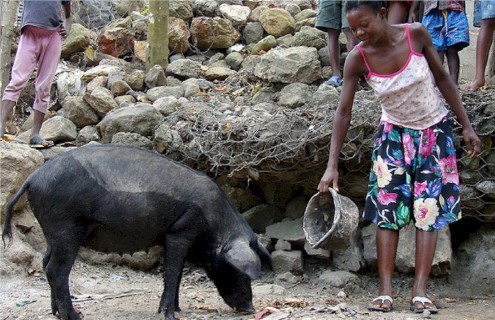 The Creole Pig
was a breed of pig indigenous to the
Caribbean nation of Haiti. Creole pigs are
well adapted to the rugged terrain and sparse vegetation of Haiti. The pigs
resilience allowed Haitian peasants to raise these pigs with little resources.
The peasants characterized their pigs as
never getting sick.
The Creole Pig
was a breed of pig indigenous to the
Caribbean nation of Haiti. Creole pigs are
well adapted to the rugged terrain and sparse vegetation of Haiti. The pigs
resilience allowed Haitian peasants to raise these pigs with little resources.
The peasants characterized their pigs as
never getting sick.For generations, the Haitian Creole pig had been a poor Haitian familys most important economic asset. Rugged foragers that coped well in Haiti’s tropical climate, Creole pigs were cheap and easy for peasant families to raise. Beyond meat, the pigs real significance lay in their role as a peasants savings bank an asset that could easily be tapped into when cash was needed. These dark black pigs were known for the ...

 Cul Noir Du Limousine
Cul Noir Du Limousine
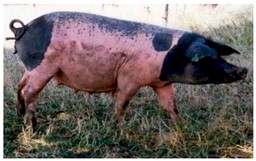 Cul Noir Du Limousine pigs, also known as "Black Limousin" pigs, are a rare breed of swine originating from the Limousin region of France. They are characterized by their distinct black and white markings, their compact build, and their docile temperament. Cul Noir Du Limousine pigs are classified as medium-sized hogs, typically weighing between 200 and 250 kilograms (441 and 551 pounds) at maturity. Their build is compact and muscular, with a slightly arched back and a deep chest. Their heads are medium in size, featuring erect ears and a slightly dished snout. Their coats exhibit a black and white coloration, with the black patches typically covering the head, shoulders, back, and legs.
Cul Noir Du Limousine pigs, also known as "Black Limousin" pigs, are a rare breed of swine originating from the Limousin region of France. They are characterized by their distinct black and white markings, their compact build, and their docile temperament. Cul Noir Du Limousine pigs are classified as medium-sized hogs, typically weighing between 200 and 250 kilograms (441 and 551 pounds) at maturity. Their build is compact and muscular, with a slightly arched back and a deep chest. Their heads are medium in size, featuring erect ears and a slightly dished snout. Their coats exhibit a black and white coloration, with the black patches typically covering the head, shoulders, back, and legs.
Cul Noir Du Limousine pigs are widely ...

 Cumberland
Cumberland
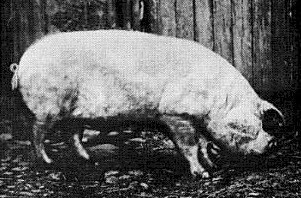 Cumberland Pigs
were a pig from Northern England that are now extinct. They were used to
produce local delicacies like the Cumberland sausage and Cumberland ham. The
breed became extinct in 1960, after changes in farming methods and a demand for
less fatty meat led to it falling out of favor.
Cumberland Pigs
were a pig from Northern England that are now extinct. They were used to
produce local delicacies like the Cumberland sausage and Cumberland ham. The
breed became extinct in 1960, after changes in farming methods and a demand for
less fatty meat led to it falling out of favor.
Cumberland Pigs were a very old breed that likely developed over several hundred years in Cumberland and Westmorland, and was closely related to the Old Yorkshire white pig. They were a heavy-set white pig with pendulous ears, and a tough constitution that enabled them to withstand the poor weather of Northern England. During the 19th century, many efforts were made to improve pig breeds, and the Cumberland was often crossed w ...

 Czech Improved White
Czech Improved White
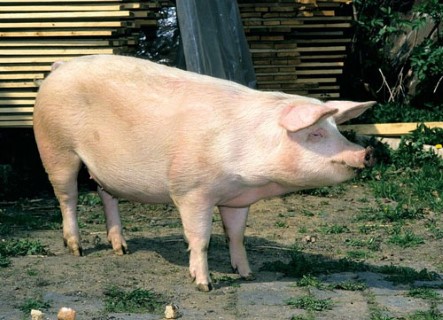 Czech Improved White Pigs, a staple across the Czech Republic, trace their lineage to a meticulous blend of Large White, Edelschwein, and German Landrace pigs, carefully crossed with indigenous swine breeds. This strategic amalgamation resulted in a versatile porcine lineage that not only thrives in diverse environments but also serves as the progenitor for subsequent breeds like the Slovakian Improved White and Slovakian White Meat.
Czech Improved White Pigs, a staple across the Czech Republic, trace their lineage to a meticulous blend of Large White, Edelschwein, and German Landrace pigs, carefully crossed with indigenous swine breeds. This strategic amalgamation resulted in a versatile porcine lineage that not only thrives in diverse environments but also serves as the progenitor for subsequent breeds like the Slovakian Improved White and Slovakian White Meat.
Characterized by their pristine white coats and distinctive short, erect ears, Czech Improved White Pigs epitomize resilience and adaptability. Their robust constitution and medium to large physique underscore their suitability for a wide range of husbandry practices. Renowned for their exceptional f ...
